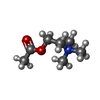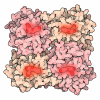[English] 日本語
 Yorodumi
Yorodumi- PDB-9gu2: Human adult muscle nAChR in desensitised state in nanodisc with 1... -
+ Open data
Open data
- Basic information
Basic information
| Entry | Database: PDB / ID: 9gu2 | |||||||||
|---|---|---|---|---|---|---|---|---|---|---|
| Title | Human adult muscle nAChR in desensitised state in nanodisc with 100 uM acetylcholine | |||||||||
 Components Components |
| |||||||||
 Keywords Keywords | MEMBRANE PROTEIN / Ligand-gated ion channel / nicotinic receptor / pLGIC / cys-loop receptor | |||||||||
| Function / homology |  Function and homology information Function and homology informationpostsynaptic membrane organization / skeletal muscle tissue growth / musculoskeletal movement / Highly sodium permeable postsynaptic acetylcholine nicotinic receptors / Highly calcium permeable nicotinic acetylcholine receptors / Highly calcium permeable postsynaptic nicotinic acetylcholine receptors / acetylcholine receptor activity / acetylcholine-gated channel complex / behavioral response to nicotine / neuromuscular synaptic transmission ...postsynaptic membrane organization / skeletal muscle tissue growth / musculoskeletal movement / Highly sodium permeable postsynaptic acetylcholine nicotinic receptors / Highly calcium permeable nicotinic acetylcholine receptors / Highly calcium permeable postsynaptic nicotinic acetylcholine receptors / acetylcholine receptor activity / acetylcholine-gated channel complex / behavioral response to nicotine / neuromuscular synaptic transmission / acetylcholine-gated monoatomic cation-selective channel activity / muscle cell development / acetylcholine binding / synaptic transmission, cholinergic / monoatomic cation transmembrane transporter activity / nervous system process / acetylcholine receptor signaling pathway / ligand-gated monoatomic ion channel activity / postsynaptic specialization membrane / neuromuscular process / muscle cell cellular homeostasis / neuromuscular junction development / monoatomic cation transport / membrane depolarization / skeletal muscle contraction / neuronal action potential / muscle contraction / bioluminescence / generation of precursor metabolites and energy / response to nicotine / regulation of membrane potential / transmitter-gated monoatomic ion channel activity involved in regulation of postsynaptic membrane potential / neuromuscular junction / neuron cellular homeostasis / transmembrane signaling receptor activity / channel activity / monoatomic ion transmembrane transport / chemical synaptic transmission / postsynaptic membrane / neuron projection / synapse / cell surface / signal transduction / plasma membrane Similarity search - Function | |||||||||
| Biological species |  Homo sapiens (human) Homo sapiens (human)  | |||||||||
| Method | ELECTRON MICROSCOPY / single particle reconstruction / cryo EM / Resolution: 2.73 Å | |||||||||
 Authors Authors | Li, A. / Pike, A.C.W. / Chi, G. / Webster, R. / Maxwell, S. / Liu, W. / Beeson, D. / Sauer, D.B. / Dong, Y.Y. | |||||||||
| Funding support |  United Kingdom, 2items United Kingdom, 2items
| |||||||||
 Citation Citation |  Journal: Cell Rep / Year: 2025 Journal: Cell Rep / Year: 2025Title: Structures of the human adult muscle-type nicotinic receptor in resting and desensitized states. Authors: Anna Li / Ashley C W Pike / Richard Webster / Susan Maxwell / Wei-Wei Liu / Gamma Chi / Jacqueline Palace / David Beeson / David B Sauer / Yin Yao Dong /  Abstract: Muscle-type nicotinic acetylcholine receptor (AChR) is the key signaling molecule in neuromuscular junctions. Here, we present the structures of full-length human adult receptors in complex with ...Muscle-type nicotinic acetylcholine receptor (AChR) is the key signaling molecule in neuromuscular junctions. Here, we present the structures of full-length human adult receptors in complex with Fab35 in α-bungarotoxin (αBuTx)-bound resting states and ACh-bound desensitized states. In addition to identifying the conformational changes during recovery from desensitization, we also used electrophysiology to probe the effects of eight previously unstudied AChR genetic variants found in patients with congenital myasthenic syndrome (CMS), revealing they cause either slow- or fast-channel CMS characterized by prolonged or abbreviated ion channel bursts. The combined kinetic and structural data offer a better understanding of both the AChR state transition and the pathogenic mechanisms of disease variants. #1: Journal: Acta Crystallogr D Struct Biol / Year: 2019 Title: Macromolecular structure determination using X-rays, neutrons and electrons: recent developments in Phenix. Authors: Dorothee Liebschner / Pavel V Afonine / Matthew L Baker / Gábor Bunkóczi / Vincent B Chen / Tristan I Croll / Bradley Hintze / Li Wei Hung / Swati Jain / Airlie J McCoy / Nigel W Moriarty ...Authors: Dorothee Liebschner / Pavel V Afonine / Matthew L Baker / Gábor Bunkóczi / Vincent B Chen / Tristan I Croll / Bradley Hintze / Li Wei Hung / Swati Jain / Airlie J McCoy / Nigel W Moriarty / Robert D Oeffner / Billy K Poon / Michael G Prisant / Randy J Read / Jane S Richardson / David C Richardson / Massimo D Sammito / Oleg V Sobolev / Duncan H Stockwell / Thomas C Terwilliger / Alexandre G Urzhumtsev / Lizbeth L Videau / Christopher J Williams / Paul D Adams /    Abstract: Diffraction (X-ray, neutron and electron) and electron cryo-microscopy are powerful methods to determine three-dimensional macromolecular structures, which are required to understand biological ...Diffraction (X-ray, neutron and electron) and electron cryo-microscopy are powerful methods to determine three-dimensional macromolecular structures, which are required to understand biological processes and to develop new therapeutics against diseases. The overall structure-solution workflow is similar for these techniques, but nuances exist because the properties of the reduced experimental data are different. Software tools for structure determination should therefore be tailored for each method. Phenix is a comprehensive software package for macromolecular structure determination that handles data from any of these techniques. Tasks performed with Phenix include data-quality assessment, map improvement, model building, the validation/rebuilding/refinement cycle and deposition. Each tool caters to the type of experimental data. The design of Phenix emphasizes the automation of procedures, where possible, to minimize repetitive and time-consuming manual tasks, while default parameters are chosen to encourage best practice. A graphical user interface provides access to many command-line features of Phenix and streamlines the transition between programs, project tracking and re-running of previous tasks. | |||||||||
| History |
|
- Structure visualization
Structure visualization
| Structure viewer | Molecule:  Molmil Molmil Jmol/JSmol Jmol/JSmol |
|---|
- Downloads & links
Downloads & links
- Download
Download
| PDBx/mmCIF format |  9gu2.cif.gz 9gu2.cif.gz | 690.5 KB | Display |  PDBx/mmCIF format PDBx/mmCIF format |
|---|---|---|---|---|
| PDB format |  pdb9gu2.ent.gz pdb9gu2.ent.gz | 445.6 KB | Display |  PDB format PDB format |
| PDBx/mmJSON format |  9gu2.json.gz 9gu2.json.gz | Tree view |  PDBx/mmJSON format PDBx/mmJSON format | |
| Others |  Other downloads Other downloads |
-Validation report
| Summary document |  9gu2_validation.pdf.gz 9gu2_validation.pdf.gz | 1.8 MB | Display |  wwPDB validaton report wwPDB validaton report |
|---|---|---|---|---|
| Full document |  9gu2_full_validation.pdf.gz 9gu2_full_validation.pdf.gz | 1.8 MB | Display | |
| Data in XML |  9gu2_validation.xml.gz 9gu2_validation.xml.gz | 85.4 KB | Display | |
| Data in CIF |  9gu2_validation.cif.gz 9gu2_validation.cif.gz | 132.2 KB | Display | |
| Arichive directory |  https://data.pdbj.org/pub/pdb/validation_reports/gu/9gu2 https://data.pdbj.org/pub/pdb/validation_reports/gu/9gu2 ftp://data.pdbj.org/pub/pdb/validation_reports/gu/9gu2 ftp://data.pdbj.org/pub/pdb/validation_reports/gu/9gu2 | HTTPS FTP |
-Related structure data
| Related structure data |  51570MC  9gu0C  9gu1C  9gu3C M: map data used to model this data C: citing same article ( |
|---|---|
| Similar structure data | Similarity search - Function & homology  F&H Search F&H Search |
- Links
Links
- Assembly
Assembly
| Deposited unit | 
|
|---|---|
| 1 |
|
- Components
Components
-Acetylcholine receptor subunit ... , 4 types, 5 molecules ALBDE
| #1: Protein | Mass: 49747.645 Da / Num. of mol.: 2 Source method: isolated from a genetically manipulated source Source: (gene. exp.)  Homo sapiens (human) / Gene: CHRNA1, ACHRA, CHNRA / Plasmid: TLCV2 / Cell line (production host): Expi293F / Production host: Homo sapiens (human) / Gene: CHRNA1, ACHRA, CHNRA / Plasmid: TLCV2 / Cell line (production host): Expi293F / Production host:  Homo sapiens (human) / References: UniProt: P02708 Homo sapiens (human) / References: UniProt: P02708#2: Protein | | Mass: 54596.477 Da / Num. of mol.: 1 Source method: isolated from a genetically manipulated source Source: (gene. exp.)  Homo sapiens (human) / Gene: CHRNB1, ACHRB, CHRNB / Plasmid: TLCV2 / Cell line (production host): Expi293F / Production host: Homo sapiens (human) / Gene: CHRNB1, ACHRB, CHRNB / Plasmid: TLCV2 / Cell line (production host): Expi293F / Production host:  Homo sapiens (human) / References: UniProt: P11230 Homo sapiens (human) / References: UniProt: P11230#3: Protein | | Mass: 56915.359 Da / Num. of mol.: 1 Source method: isolated from a genetically manipulated source Source: (gene. exp.)  Homo sapiens (human) / Gene: CHRND, ACHRD / Plasmid: TLCV2 / Cell line (production host): Expi293F / Production host: Homo sapiens (human) / Gene: CHRND, ACHRD / Plasmid: TLCV2 / Cell line (production host): Expi293F / Production host:  Homo sapiens (human) / References: UniProt: Q07001 Homo sapiens (human) / References: UniProt: Q07001#4: Protein | | Mass: 80603.750 Da / Num. of mol.: 1 Mutation: EGFP insertion between residues R344 and A345 in the M3-M4 intracellular loop Source method: isolated from a genetically manipulated source Source: (gene. exp.)  Homo sapiens (human), (gene. exp.) Homo sapiens (human), (gene. exp.)  Gene: CHRNE, ACHRE, GFP / Plasmid: TLCV2 / Cell line (production host): Expi293F / Production host:  Homo sapiens (human) / References: UniProt: Q04844, UniProt: P42212 Homo sapiens (human) / References: UniProt: Q04844, UniProt: P42212 |
|---|
-Antibody , 2 types, 4 molecules CGFH
| #5: Antibody | Mass: 23392.982 Da / Num. of mol.: 2 Source method: isolated from a genetically manipulated source Source: (gene. exp.)   #6: Antibody | Mass: 23879.758 Da / Num. of mol.: 2 Source method: isolated from a genetically manipulated source Source: (gene. exp.)   |
|---|
-Sugars , 5 types, 7 molecules 
| #7: Polysaccharide | Source method: isolated from a genetically manipulated source #8: Polysaccharide | Source method: isolated from a genetically manipulated source #9: Polysaccharide | 2-acetamido-2-deoxy-beta-D-glucopyranose-(1-2)-alpha-D-mannopyranose-(1-3)-[alpha-D-mannopyranose- ...2-acetamido-2-deoxy-beta-D-glucopyranose-(1-2)-alpha-D-mannopyranose-(1-3)-[alpha-D-mannopyranose-(1-3)-alpha-D-mannopyranose-(1-6)]beta-D-mannopyranose-(1-4)-2-acetamido-2-deoxy-beta-D-glucopyranose-(1-4)-2-acetamido-2-deoxy-beta-D-glucopyranose | Type: oligosaccharide / Mass: 1276.157 Da / Num. of mol.: 1 Source method: isolated from a genetically manipulated source #10: Polysaccharide | 2-acetamido-2-deoxy-beta-D-glucopyranose-(1-4)-2-acetamido-2-deoxy-beta-D-glucopyranose | Source method: isolated from a genetically manipulated source #12: Sugar | ChemComp-NAG / | |
|---|
-Non-polymers , 3 types, 98 molecules 




| #11: Chemical | | #13: Chemical | ChemComp-CU / | #14: Water | ChemComp-HOH / | |
|---|
-Details
| Has ligand of interest | Y |
|---|---|
| Has protein modification | Y |
-Experimental details
-Experiment
| Experiment | Method: ELECTRON MICROSCOPY |
|---|---|
| EM experiment | Aggregation state: PARTICLE / 3D reconstruction method: single particle reconstruction |
- Sample preparation
Sample preparation
| Component | Name: Human adult muscle nAChR in desensitised state in nanodisc with 100 uM acetylcholine Type: COMPLEX Details: nAChR in complex with acetylcholine and Fab35 in MSP2N2-soy polar lipids nanodiscs Entity ID: #1-#6 / Source: RECOMBINANT | |||||||||||||||
|---|---|---|---|---|---|---|---|---|---|---|---|---|---|---|---|---|
| Molecular weight | Value: 0.386 MDa / Experimental value: NO | |||||||||||||||
| Source (natural) | Organism:  Homo sapiens (human) Homo sapiens (human) | |||||||||||||||
| Source (recombinant) | Organism:  Homo sapiens (human) / Cell: Expi293F / Plasmid: TLCV2 Homo sapiens (human) / Cell: Expi293F / Plasmid: TLCV2 | |||||||||||||||
| Buffer solution | pH: 7.5 / Details: 20 mM HEPES pH 7.5, 150 mM NaCl | |||||||||||||||
| Buffer component |
| |||||||||||||||
| Specimen | Conc.: 2 mg/ml / Embedding applied: NO / Shadowing applied: NO / Staining applied: NO / Vitrification applied: YES / Details: This sample was monodisperse | |||||||||||||||
| Specimen support | Grid material: COPPER / Grid mesh size: 300 divisions/in. / Grid type: Quantifoil R1.2/1.3 | |||||||||||||||
| Vitrification | Instrument: FEI VITROBOT MARK IV / Cryogen name: ETHANE / Humidity: 100 % / Chamber temperature: 277.35 K / Details: 2.5 ul sample, blot time=6 s, blot force=-10 |
- Electron microscopy imaging
Electron microscopy imaging
| Experimental equipment |  Model: Titan Krios / Image courtesy: FEI Company |
|---|---|
| Microscopy | Model: TFS KRIOS / Details: objective aperture 100 um |
| Electron gun | Electron source:  FIELD EMISSION GUN / Accelerating voltage: 300 kV / Illumination mode: FLOOD BEAM FIELD EMISSION GUN / Accelerating voltage: 300 kV / Illumination mode: FLOOD BEAM |
| Electron lens | Mode: BRIGHT FIELD / Nominal magnification: 130000 X / Nominal defocus max: 2400 nm / Nominal defocus min: 800 nm / Cs: 2.7 mm / C2 aperture diameter: 50 µm / Alignment procedure: COMA FREE |
| Specimen holder | Cryogen: NITROGEN / Specimen holder model: FEI TITAN KRIOS AUTOGRID HOLDER |
| Image recording | Average exposure time: 6.84 sec. / Electron dose: 50 e/Å2 / Film or detector model: TFS FALCON 4i (4k x 4k) / Num. of grids imaged: 1 / Num. of real images: 13868 |
| EM imaging optics | Energyfilter name: TFS Selectris X / Energyfilter slit width: 10 eV |
| Image scans | Width: 4096 / Height: 4096 |
- Processing
Processing
| EM software |
| ||||||||||||||||||||||||||||||||||||||||||||||||
|---|---|---|---|---|---|---|---|---|---|---|---|---|---|---|---|---|---|---|---|---|---|---|---|---|---|---|---|---|---|---|---|---|---|---|---|---|---|---|---|---|---|---|---|---|---|---|---|---|---|
| CTF correction | Type: PHASE FLIPPING AND AMPLITUDE CORRECTION | ||||||||||||||||||||||||||||||||||||||||||||||||
| Particle selection | Num. of particles selected: 2034352 / Details: extracted by topaz picking | ||||||||||||||||||||||||||||||||||||||||||||||||
| Symmetry | Point symmetry: C1 (asymmetric) | ||||||||||||||||||||||||||||||||||||||||||||||||
| 3D reconstruction | Resolution: 2.73 Å / Resolution method: FSC 0.143 CUT-OFF / Num. of particles: 175800 / Algorithm: FOURIER SPACE / Details: Non-uniform refinement / Num. of class averages: 1 / Symmetry type: POINT | ||||||||||||||||||||||||||||||||||||||||||||||||
| Atomic model building | Protocol: FLEXIBLE FIT / Space: REAL Details: Initial fitting of alphafold models using chimeraX followed by manual rebuilding in COOT and final refinement in ISOLDE and PHENIX | ||||||||||||||||||||||||||||||||||||||||||||||||
| Atomic model building |
| ||||||||||||||||||||||||||||||||||||||||||||||||
| Refinement | Cross valid method: NONE Stereochemistry target values: GeoStd + Monomer Library + CDL v1.2 | ||||||||||||||||||||||||||||||||||||||||||||||||
| Displacement parameters | Biso mean: 122.23 Å2 | ||||||||||||||||||||||||||||||||||||||||||||||||
| Refine LS restraints |
|
 Movie
Movie Controller
Controller





 PDBj
PDBj








